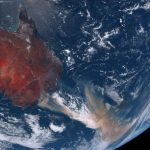 May 27, 2021 12:11 pm
Published by Climate Extremes
May 27, 2021 12:11 pm
Published by Climate Extremes
An unusual southern stratospheric warming event amplified the conditions that led to the Black Summer bushfires of 2019/20. CLEX researchers explored how frequently these rare warming events may occur with climate change.
 January 15, 2021 9:49 am
Published by Climate Extremes
January 15, 2021 9:49 am
Published by Climate Extremes
CLEX researchers introduced a novel methodology to examine the Southern Ocean's response to changing winds. They performed numerical simulations with a global ocean‐sea ice model suite that spans a hierarchy of spatial resolutions and driven by realistic atmospheric forcing conditions.
 January 12, 2021 11:27 am
Published by Climate Extremes
January 12, 2021 11:27 am
Published by Climate Extremes
To shed more light on short droughts of the past, CLEX researchers took advantage of a newly released dataset from the Bureau of Meteorology to re-examine the infamous Centennial Drought of 1888. Using the new dataset along with historical station data, they analysed monthly rainfall variability across south eastern Australia throughout 1888.
 December 14, 2020 11:45 am
Published by Climate Extremes
December 14, 2020 11:45 am
Published by Climate Extremes
It has been remarkable how much we have achieved in this extraordinarily difficult year. Research coming out of the Teleconnections and Variability program over the past four months has strongly focused on how influences in one part of the world can have direct impacts on another.
 December 12, 2020 5:11 pm
Published by Climate Extremes
December 12, 2020 5:11 pm
Published by Climate Extremes
It has been remarkable how much we have achieved in this extraordinarily difficult year. Research coming out of the Teleconnections and Variability program over the past four months has strongly focused on how influences in one part of the world can have direct impacts on another.
 November 24, 2020 12:09 pm
Published by Climate Extremes
November 24, 2020 12:09 pm
Published by Climate Extremes
By grouping weather systems by similar patterns rather than averaging conditions over months, seasons or years, CLEX researchers found that between Australia and Antarctica, the ‘doughnut’ structure of SAM is split into multiple ‘flavours’ and is more likely to have ‘bite marks’ out of it than be a perfect ring.
 August 6, 2020 3:47 pm
Published by Jenny Rislund
August 6, 2020 3:47 pm
Published by Jenny Rislund
In this project you will investigate the competing effects the Antarctic ozone hole and increasing greenhouse gases have on the Australian summer season rainfall, using the latest climate models. These are now available on the National Computing Infrastructure (NCI) supercomputer and are being used as input into the Intergovernmental Panel on Climate Change’s Sixth Assessment Report.
 February 12, 2020 1:38 pm
Published by Climate Extremes
February 12, 2020 1:38 pm
Published by Climate Extremes
Research by CLEX scientists and colleagues re-examines some of the basic assumptions and interpretations in the theory. In particular, they show the SAM cannot be interpreted as a descriptor of mid-latitude variability and it has little imprint on the weather of the storm track.
 July 15, 2019 1:00 am
Published by Climate Extremes
July 15, 2019 1:00 am
Published by Climate Extremes
This project will use output from state-of-the-art climate simulations of the Last Millennium (850–2005 CE) to explore the long-term variability of an Australian climate driver of the student’s choice. The student will explore the natural variability of that driver to determine its long-term context, and compare with palaeoclimate reconstructions (proxies) where possible.
 June 5, 2019 3:25 pm
Published by Climate Extremes
June 5, 2019 3:25 pm
Published by Climate Extremes
Large areas of northern Queensland experienced extreme rainfall and severe flooding in late January and February 2019. This briefing note examines the impacts and some of the likely causes of the event.










